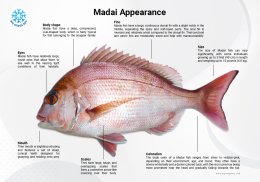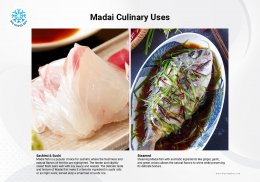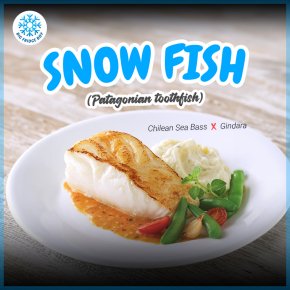What is Madai fish (Japanese red snapper) ?
Last updated: 25 Apr 2023 | 10135 Views |
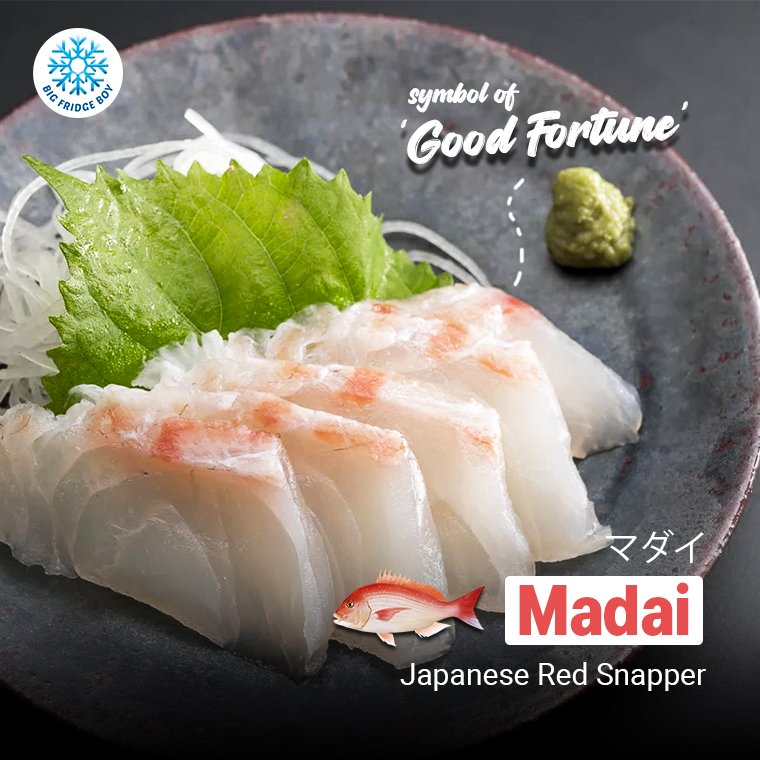
Madai fish (マダイ), also known as Red Sea Bream or Japanese Red Snapper, is a highly prized fish in Japanese cuisine. It is popular for its delicious taste, tender texture, and rich nutritional content. The name "Madai" translates to "tai" in Japanese, indicating its premium status among snappers. In Japan, Madai fish is considered a symbol of good fortune and is often served during special occasions like weddings and New Year celebrations. The Madai fish can be found in the western Pacific Ocean, from Japan to Australia, and is typically caught in deeper waters. Let's explore the culinary wonders of Madai fish and how to best savor its flavors.
In Japanese culture, the Madai fish is considered a symbol of good fortune and prosperity due to several reasons:
- Color
The red or reddish-pink color of the Madai fish is associated with auspiciousness and celebration in Japanese culture. Red is traditionally considered a lucky color, symbolizing happiness, success, and good health. - Name
The name "Madai" in Japanese has two characters, "ma" (真) and "dai" (鯛). The character "dai" (鯛) means "sea bream," which is phonetically similar to "medetai" (めでたい), a Japanese term expressing joy or a festive mood. The association between the fish's name and this expression strengthens the connection between Madai and auspicious occasions. - Rarity and Value
Madai fish are highly prized for their delicious taste and tender texture, making them a sought-after delicacy in Japanese cuisine. Their high market value and perceived luxury contribute to their association with prosperity and special occasions. - Seasonality
Madai fish are considered to be at their peak quality during the winter months, particularly around the New Year. As a result, they are often served during New Year's celebrations and other festive events, reinforcing their association with good fortune and auspicious beginnings.
Madai fish have a relatively long lifespan, with some living up to 18 years in the wild.
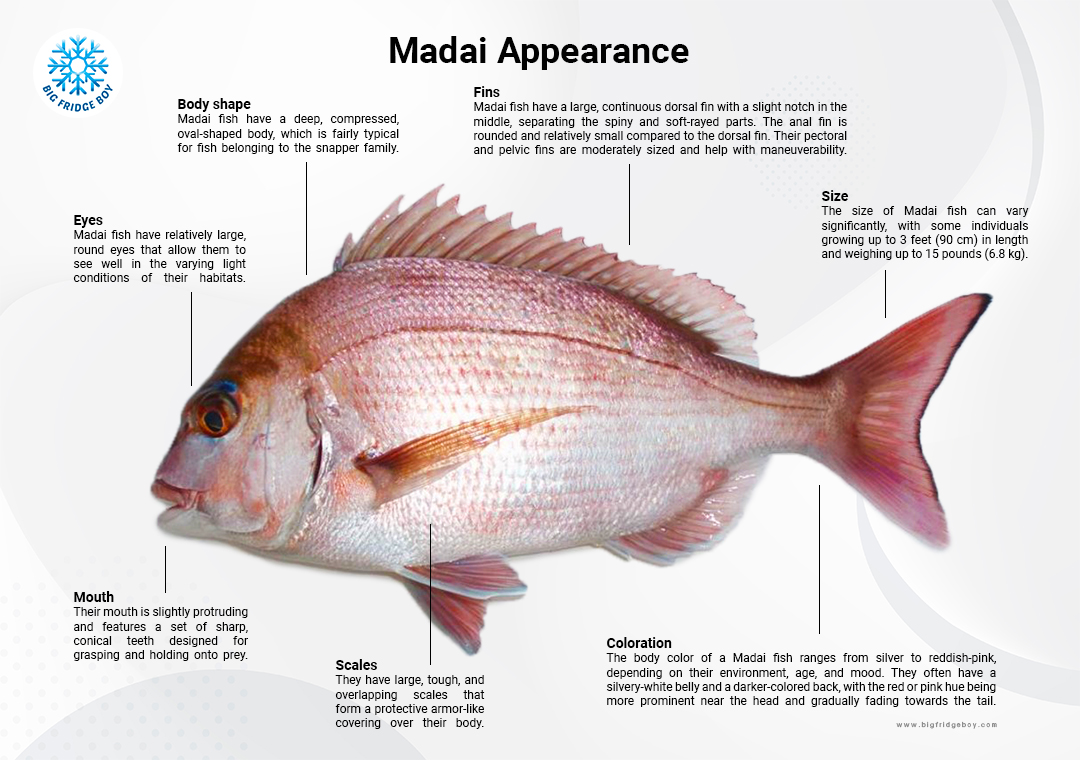
Appearance
- Body Shape
Madai fish have a deep, compressed, oval-shaped body, which is fairly typical for fish belonging to the snapper family. - Coloration
The body color of a Madai fish ranges from silver to reddish-pink, depending on their environment, age, and mood. They often have a silvery-white belly and a darker-colored back, with the red or pink hue being more prominent near the head and gradually fading towards the tail. - Fins
Madai fish have a large, continuous dorsal fin with a slight notch in the middle, separating the spiny and soft-rayed parts. The anal fin is rounded and relatively small compared to the dorsal fin. Their pectoral and pelvic fins are moderately sized and help with maneuverability. - Scales
They have large, tough, and overlapping scales that form a protective armor-like covering over their body. - Eyes
Madai fish have relatively large, round eyes that allow them to see well in the varying light conditions of their habitats. - Mouth
Their mouth is slightly protruding and features a set of sharp, conical teeth designed for grasping and holding onto prey. - Size
The size of Madai fish can vary significantly, with some individuals growing up to 3 feet (90 cm) in length and weighing up to 15 pounds (6.8 kg).

Habitat
Madai fish, or Red Sea Bream, are typically found in a wide range of depths, depending on their life stage, the season, and the specific region. Generally, they inhabit depths between 30 and 650 feet (10 to 200 meters) in the western Pacific Ocean.
During the winter months, Madai fish tend to migrate to deeper waters, sometimes reaching depths of around 500 feet (150 meters) or more. In the warmer months, they return to shallower waters, often closer to 100 feet (30 meters) deep or less, as they move closer to the shore to spawn.
The depth at which Madai fish are found can impact the flavor and texture of their flesh, with those caught at greater depths usually having a richer taste and more tender, succulent texture due to higher fat content. The preferred water temperature for Madai fish is usually between 59°F and 68°F (15°C and 20°C).
- Seto Inland Sea
This large, sheltered body of water lies between the main islands of Honshu, Shikoku, and Kyushu. The Seto Inland Sea is known for its rich marine biodiversity, including the Madai fish. - Tsushima Strait
This strait separates Japan's Kyushu Island from South Korea and connects the East China Sea with the Sea of Japan. Madai fish can be found in the waters around Tsushima Island, which is part of the Nagasaki Prefecture. - Sea of Japan
The coastal areas along the Sea of Japan, particularly along the western side of Honshu, are known to host Madai fish populations. - Sagami Bay
Located south of Tokyo, Sagami Bay is a popular fishing ground for various species, including Madai fish. - Suruga Bay
Situated along the central coast of Honshu, Suruga Bay is a deep-water bay that provides suitable habitat for the Madai fish.
Peak season
The best season to eat Madai fish is during the winter months, particularly from November to April. During this period, Madai fish are known to have a higher fat content, which contributes to a richer taste and a more tender, succulent texture. This is because the fish store more fat to survive in the colder, deeper waters where they migrate during winter.
As a result, winter-caught Madai is considered a delicacy and is highly prized in Japanese cuisine. This is also the time when Madai fish are traditionally served during special occasions, such as New Year celebrations, symbolizing good fortune and prosperity. However, Madai fish can still be enjoyed year-round, with the quality and taste varying depending on the season and fishing location.
Health Benefits
- Rich in Omega-3 Fatty Acids
Madai fish is an excellent source of Omega-3 fatty acids, which are essential for maintaining heart health, reducing inflammation, and supporting brain function. - High-quality Protein
Madai fish offers a complete source of high-quality protein, which helps build and repair body tissues, support immune function, and maintain overall health. - Low in Calories and Fat
With its lean, white flesh, Madai fish is low in calories and fat, making it an excellent choice for those watching their weight or following a heart-healthy diet.
Taste
Madai fish is known for its tender, moist, and flaky texture, which makes it highly desirable in various culinary applications. The flesh of the fish is lean and white, with a delicate yet firm consistency that is easy to work with in the kitchen.
As for taste, Madai fish boasts a mildly sweet and subtly savory flavor profile. The taste is often described as clean and delicate, allowing it to pair well with a variety of seasonings and sauces without being overpowering. The combination of its appealing texture and pleasing taste has made Madai fish a popular choice in many cuisines, particularly in Japanese dishes like sashimi, sushi, and grilled preparations.
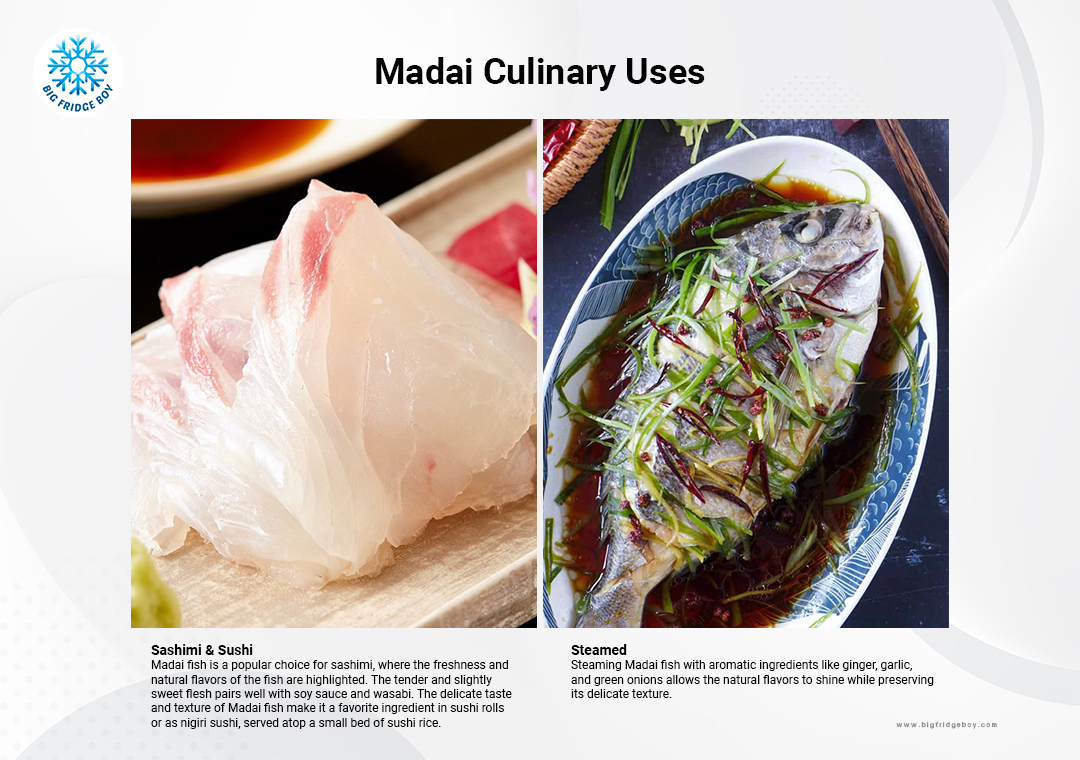
Culinary Uses
- Sashimi&Sushi
Madai fish is a popular choice for sashimi, where the freshness and natural flavors of the fish are highlighted. The tender and slightly sweet flesh pairs well with soy sauce and wasabi. The delicate taste and texture of Madai fish make it a favorite ingredient in sushi rolls or as nigiri sushi, served atop a small bed of sushi rice. - Grilled
Grilling Madai fish is a popular cooking technique that emphasizes the fish's natural flavors while imparting a delightful smoky aroma. Grilling at high heat ensures that the skin becomes crispy, while the flesh remains tender and succulent. Madai fish can be grilled either whole or as fillets and can be seasoned with a simple sprinkle of salt or a light soy sauce marinade. This method of preparation highlights the delicate taste and texture of the fish, making it a flavorful and enjoyable dish. - Steamed
Steaming Madai fish with aromatic ingredients like ginger, garlic, and green onions allows the natural flavors to shine while preserving its delicate texture. - Simmered
Madai fish can also be simmered in a flavorful broth with vegetables, creating a delicious and comforting dish.
Madai fish, Red Sea Bream or Japanese Red Snapper It is a high-value fish. found in the western Pacific Ocean, especially in the coastal waters of Japan, Madai is known for its delicate flavor. soft texture, clean white flesh, and have good nutritional value. low calories and fat Can be used to cook a variety of dishes. From raw sashimi to grilling, steaming, or making soups, they are at their best during late winter. It is popular for Japanese food and so on.

